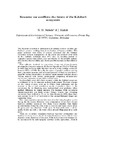| dc.contributor.author | Moleele, N.M. | |
| dc.contributor.author | Mainah, J. | |
| dc.date.accessioned | 2009-12-04T10:28:30Z | |
| dc.date.available | 2009-12-04T10:28:30Z | |
| dc.date.issued | 2003 | |
| dc.identifier.citation | Moleele, N.M. & Mainah, J. (2003) Resource use conflicts: the future of the Kalahari ecosystem, Journal of Arid Environments, vol. 54, pp. 405-425. | en_US |
| dc.identifier.issn | 0140-1963 | |
| dc.identifier.uri | http://hdl.handle.net/10311/411 | |
| dc.description.abstract | The Kalahari ecosystem is characterized by natural resource conflicts and
land-use pressure resulting from intensification of human activities. This
paper addresses three issues of concern associated with the Kalahari
ecosystem resource management: (i) the major land-use/land cover shifts
in the Kalahari ecosystem since 1970 and the resulting pattern in
vegetation species composition, cover and density; (ii) the possible explanations
for the observed shifts; and (iii) the possible resource conflicts likely to
arise.
Data collection involved the comparison of two sets of panchromatic
photographs along two transects (Hukunsti–Ngwatle and Tshane–Tsabong)
to study land-use/cover shifts that have occurred in the Kalahari ecosystem
between 1971 and 1986. Secondly, the nature of possible conflicts resulting
from population pressure and associated patterns of land-use was investigated
by making observations on selected environmental variables along a
300km transect with diverse environments comprising different-sized
settlements, vegetation communities and land-uses.
Land-use/land cover shifts have occurred within the Kalahari ecosystem
as evidenced by the two transects analysed in this paper. The main changes
are the retreat of grass cover up to 18 kms from settlements and the
increase in thorny and non-thorny woody encroachers closer to the
settlements. In the Matsheng area, land-use/land cover gradients reflect
marked differences in human pressure. For instance, while settlements
(kraals/households) and fields around Tshane (smaller and dwindling
settlement) have declined to 5% at the 4 km distance in 1986, these landuses
account for 22?3% of land cover at 4 km around Hukuntsi (bigger and
expanding village).
Five major vegetation communities were identified using key plant species
during the dry season. However, these communities do not have distinct
land-use activities associated with them. Cattle densities were higher
in communities found far away from settlements and water points where
the grass cover was abundant. Cattle graze far from settlements to obtain
quality fodder and trek to the water points around village pans or at cattle
posts.
There are no definite boundaries between vegetation communities and
land-use activities, hence a lot of interaction between activities of these zones
depends on the dispersion of resources. Shifts in land-use/cover changes can
be accounted for by anthropogenic activities (arable agriculture, livestock grazing and human settlements) enhanced by natural factors like seasonal
variations and prolonged droughts of the mid-1980s. It is argued in this
paper that potential remedial measures include biosphere conservation
areas, resource zoning and resource modeling plans to determine land
suitability. | en_US |
| dc.language.iso | en | en_US |
| dc.publisher | Elsevier http://www.linkinghub.elsevier.com/retrieve/pii/S0140196302910992 | en_US |
| dc.subject | Kalahari ecosystem | en_US |
| dc.subject | land-use/cover | en_US |
| dc.subject | resource use conflict | en_US |
| dc.subject | Matsheng | en_US |
| dc.subject | anthropogenic activities | en_US |
| dc.subject | biosphere conservation areas | en_US |
| dc.subject | resource zoning | en_US |
| dc.title | Resource use conflicts: the future of the Kalahari ecosystem | en_US |
| dc.type | Published Article | en_US |

